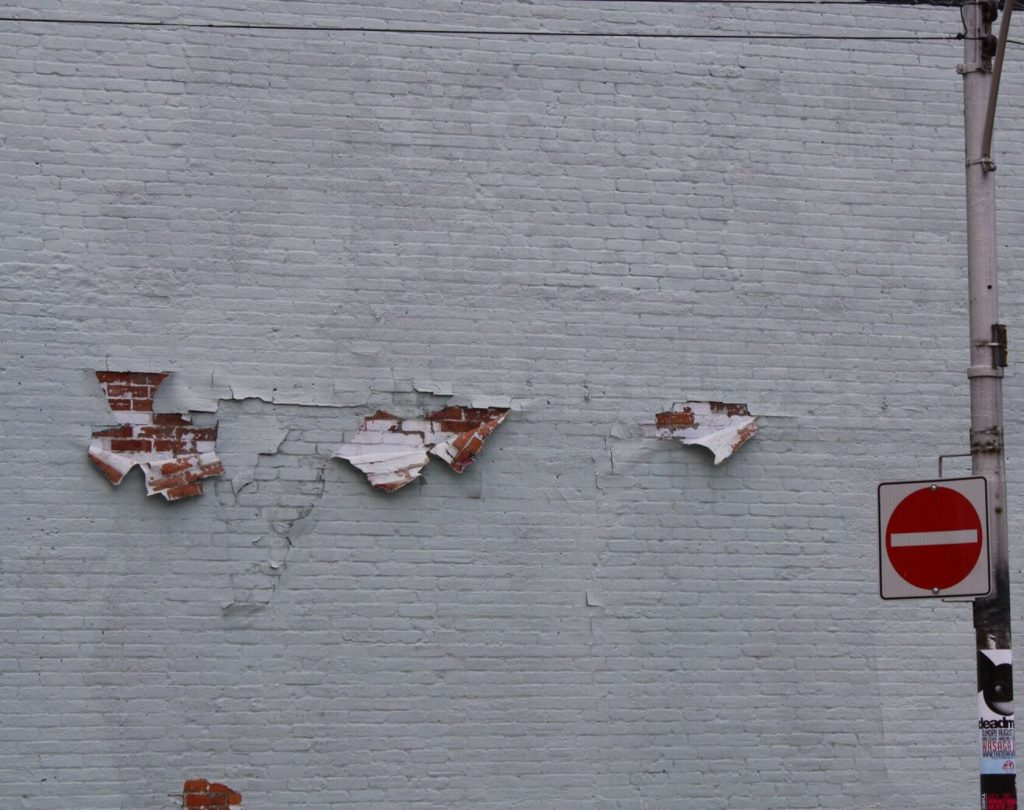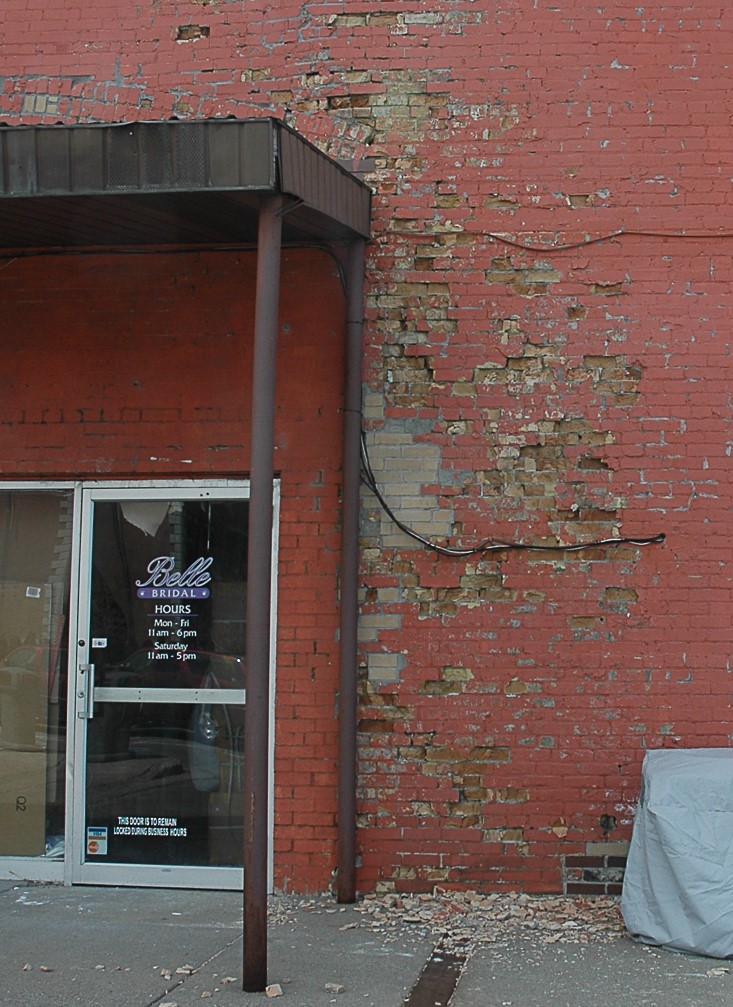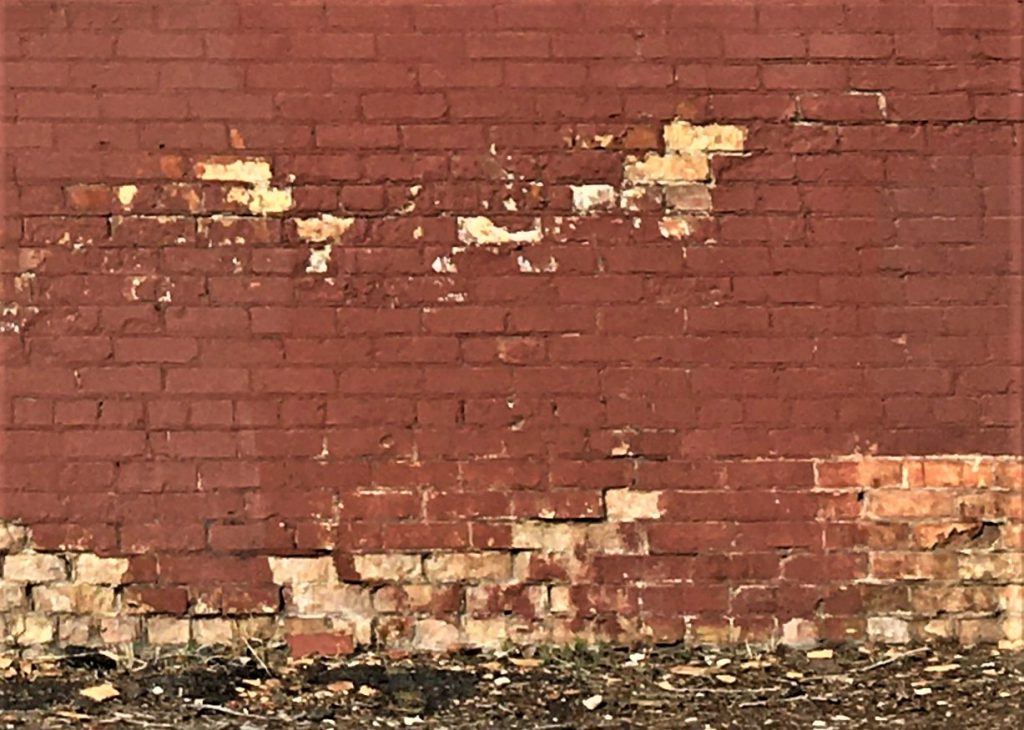By Amber Anderson, SHPO Tax Credit Coordinator

Did you know that historic masonry is meant to breathe? Whether it be brick, stone, or another type of masonry unit, masonry is not meant to be a rigid impermeable surface, and historically we understood that it needed to breathe as well as expand and contract with changes in temperature/moisture levels. Unfortunately, various things can prevent this from happening, such as paint, waterproofing or water repellent coatings, incompatible mortar replacement, or incompatible repairs (patching, stucco covering, etc.). We’ll dive deeper into incompatible mortar and repair materials in a future post, but for now let’s focus on why paint and coatings can often cause more harm than good.
Key Elements of Historic Brick Masonry Construction
Historic brick masonry construction was designed with these basic components in mind:
- Exterior bricks were fired at a higher temperature, which gave them a protective outer coating
- Interior softer bricks that were not meant to be exposed to the elements, and
- Soft mortar was designed to be the squishy sacrificial element as the bricks inevitably expanded and contracted
This system allowed a building to survive any number of conditions: all types of weather, high and low humidity, some movement, occasional biogrowth, and even efflorescence (the process by which salt and other minerals move through a masonry unit to an outer layer). As long as this intentional system remained intact, moisture was able to exit the wall and necessary expansion and contraction could take place.
Painting Brick
So what happens when you paint or add other coatings to historic masonry? This delicate process is disrupted. While some paints are worse than others, any coating that prevents the masonry assembly from acting as it was intended has the potential to do more harm than good. Paints and coatings, though often applied with good intentions, will ultimately provide a barrier that prevents moisture from escaping the masonry, causing a ripple effect of deterioration (more on that below).
But I know what you’re thinking—if paint prevents moisture from escaping, shouldn’t it also prevent it from entering? And the answer is yes, but with a big caveat. It is nearly impossible to truly waterproof any historic masonry assembly, and, therefore, water will ALWAYS get in somewhere. Even if a truly watertight surface was given to the exterior of the building, water would still get in from the interior by way of humans and plumbing, through the ground by the process of rising damp often due to improper drainage, a leaky roof, and even the exterior walls when inevitably a section of the coating is compromised.
What Harm Can A Little Water Do?
And what happens once the moisture is inside the wall? If not allowed to escape efficiently, moisture can cause any number of problems. These range from simply causing the paint to flake as the moisture leaves the surface (which is annoying) up through severe damage-caused by the freeze-thaw cycles that characterize Utah’s climate. Have you ever put a glass jar filled to the top with liquid in a freezer? If so, you are all too familiar with the fact that ice takes up more space than water. Now imagine that water trapped inside a masonry wall that then freezes and has to go somewhere. The path of least resistance, unfortunately, is for the brick or stone itself to crack and break apart.


A similar and related process happens with biological growth in a wall assembly. A small crack allows water and biological material (think fungus and plant roots and stems) into the wall, water spurs the material’s growth, the biogrowth funnels more water into the wall, and the vicious cycle continues. And let’s not even get started on what happens when water gets trapped in a wall that has metal rebar!
Why You Should Avoid Waterproofing and Water Repellents
A problematic proposal that we often get at the SHPO is the application of a waterproofing or water repellent coating to the outside base of an exterior masonry wall. Often the well-intended property owner is trying to address deterioration that has been caused by moisture in this area, and the hope is that these coatings will prevent this from continuing. But, yet again, this good intention is misguided.
First we have to ask why this area of the building is so prone to water-based deterioration? Most of the time it’s due to improper drainage in the form of an impervious surface directly adjacent to the wall. If you have a concrete pad that runs right up to a masonry wall, where is water supposed to go? Not only is it going to splash back up from the concrete onto the wall but it is also going to pool at the low spots, contributing to issues like rising damp.
While waterproofing treatments are never a good idea unless all surfaces can be truly and perpetually covered (very rarely the case), water repellent treatments are only ever a good idea in highly selective areas –and never over an entire surface. While water repellents are better alternatives because they at least allow water vapor to escape, they still come with problems, which sometimes includes unappealing visual properties. Also, what do you think happens when water vapor is allowed to condense? It becomes water, which water repellent coatings DO NOT allow to pass through. And then we’re back to square one.

How Can We Protect Our Old Brick?
If you are concerned about water entering your building, start asking root cause questions: Is water actually causing a problem? If so, why and how? A well-maintained masonry building surrounded by proper drainage should not have major water intrusion issues. The right path forward here will depend on many factors, so feel free to reach out and we’ll be happy to get you pointed in the right direction. On the other hand, some people may actually just want to change the appearance of their brick. But did you know that the original color, texture, and finish of your brick is historically significant? We could write a whole other post on this topic, but start here for now. And lastly, if your building is already painted, reach out to our office or hang tight –we will dive into the problems and options for paint removal in a future post.
Do you have any horror stories or successes to share? We would love to hear about them on our social media! Click a link below and let us know how the historic brick in your life is faring.
